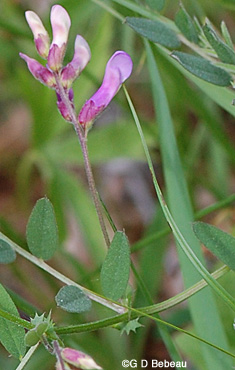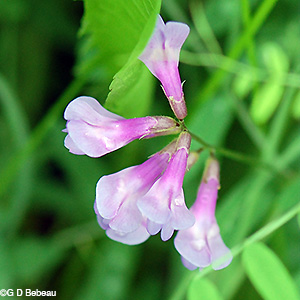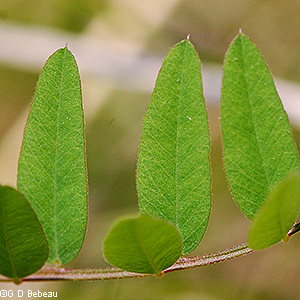The Friends of the Wildflower Garden, Inc.
Plants of the Eloise Butler Wildflower Garden
The oldest public wildflower garden in the United States

Common Name
American Vetch (Purple Vetch, American Deer Vetch)
Scientific Name
Vicia americana Muhl. ex Willd.
Plant Family
Pea (Fabaceae)
Garden Location
Upland
Prime Season
Late spring to early summer
American Vetch is one of few late May - early June blooming plants in the Upland Garden - a native perennial vine that has a single stem whose the length can reach to three feet with moderate branching. The 4-angled stems sprawl and climb on other plants in subsp. americana and are more erect and non-climbing on subsp. minor.
Leaves are highly variable in this species. All are alternate, pinnately divided with each leaf having usually 4 to 8 pairs of elliptical, wedge-shaped or narrow-oblong leaflets. There are one to three branching tendrils at the leaf tip for climbing (varies by subspecies - subsp. minor is non-branching and non-climbing) and at the base of the leaf is a stipule (small leaf-like growth) that is pointed at each end and with three sharp teeth in the middle. This stipule is distinctive for this species. Each leaflet may have a very short stalk and the tip may be rounded or have a short pointed elongation of the central vein projecting from the tip. Margins are usually entire but some plants may have leaflets with 1 to 5 teeth. Leaflets may be paired opposite each other or slightly offset from each other. Leaflets decrease in size toward the tip of the leaf. On some plants the leaflet may have hair, other plants they may be without hair.
The inflorescence is a loosely arranged raceme containing 3 to 9 flowers with individual flowers on short stalks. (5 to 9 in subsp. americana and 3 to 4 in subsp. minor). Flowers tend to be arranged in one plane of the raceme.
Flowers are 5-parted, about 3/4 inch long, with the corolla pinkish-bluish in color and the petals irregular in shape, similar to most peas in appearance. Color may also be more purple on some plants. A large petal forms the upright banner which has a notch in the center. Two petals are lateral and projecting forward, while the other two close together to form a keel which encloses the reproductive parts. The keel petals are beneath and tucked under the laterals. The style has a hairy tuft below the apex in the Vicia genus. With age the pink color fades to bluish-white. The calyx is green on the bottom and shades to reddish pink on the top. It has 5 pointed unequally sized teeth (except in subsp. mexicana where they are equal).
Seed: Flowers mature to a linear light brown seed pod resembling the garden pea, but flat, containing two or more brown seeds. The pod splits and twists at maturity to release the seeds.
Subspecies: Three, see notes at page bottom.
Habitat: American Vetch grows well in open woods, prairies and semi-shaded areas, wet mesic to mesic moisture conditions. The plant spreads by rootstocks (rhizomes) and like most vetches, care should be taken in planting this in the home garden.
Names: The genus, Vicia, is the Latin word for pea-type plants. The species, americana, is of course, 'of America'. The author name for the plant classification is two-part: First to classify was ‘Muhl’ which refers to Gotthilf Heinrich Ernst Muhlenberg (1753-1815) American Botanist who produced several catalogues of plants after retiring as a Lutheran pastor. His work was revised by the other author ‘Willd.’ - Carl Ludwig Willdenow (1765-1812), German botanist, a founder of the study of the geographic distribution of plants. He was director and curator of the Botanic Garden of Berlin.
Similar plant: American Vetch is similar in form and description to Veiny Pea, Lathyrus venosus - the key difference for immediately distinguishing the two is the leaf stipule, which in L. venosus has somewhat of an arrow shape and no teeth. Veiny Pea also has a denser flower cluster. Another member of the Vicia genus found in Minnesota is Hairy Vetch, V. villosa. There the flower raceme is longer, the calyx is very hairy and swollen at the base, the plant is much more hairy overall and the stipule of the leaf is more ovate and without sharp teeth. Lathyrus palustris, Marsh Pea, also has a tendril at the tip and pink flowers but the leaflets are very long and narrow and the stipules are different.
All photos below are of subsp. americana.



Above: 1st photo - The flower raceme springs from the leaf axil. Note the angled stem and the toothed leaf stipule. 2nd photo - Leaflets are in pairs with the toothed stipule at the base of the leaf. 3rd photo - each leaf ends with a branching tendril.
Below: Each flower is on a short stalk. The calyx has lobes (teeth) of unequal size.


Below: 1st photo - Leaflets may be arranged slightly offset for each other or opposite each other as seen in the upper photo. 2nd photo - The leaflet tip may have a sharply pointed extension of the central vein.


Below: 1st photo - Petal arrangement - A large petal forms the upright banner which has a notch in the center. Two petals are lateral and fold downward to envelope the two that form a keel. The calyx is green on the bottom and shades to reddish pink on the top. It has 5 pointed teeth. 2nd photo - The distinguishing leaf stipule, each side with a pointed end and three sharp teeth.


Below: 1st photo - The seed pods forming, each containing several seeds. 2nd photo - Brown pods at maturity; note how the upper pod has already split and twisted to eject seeds.


Notes: American Vetch is indigenous to the Garden area. Eloise Butler catalogued it on May 25, 1907. She planted some in Sept. 1918 from Hazel Park in St. Paul. Martha Crone noted it in bloom in 1939 and listed it on her 1951 census. American Vetch occurs throughout North America with the exception of the SE U.S., New England, and the Canadian maritime provinces. In Minnesota it has been reported in all counties except Freeborn and Isanti.
Subspecies: Three; two subspecies or varieties are in Minnesota, subsp. americana and subsp. minor; subsp. americana being the most prevalent and is considered to be the "eastern" species geographically. The third subspecies is subsp. mexicana and is found only in Mexico and has equal size calyx teeth. Subsp. americana has more flowers per inflorescence - 5 to 9, sprawling stems with twining tendrils, whereas subsp. minor has 3 to 4 flowers per inflorescence, erect stems, non-twining tendrils. The Garden population has not been identified to the subspecies level.
American Vetch is one of five species of Vicia commonly found in Minnesota, all but one introduced. The native species is V. americana, American Vetch; the others are: V. angustifolia, Narrow-leaved Vetch; V. cracca, Tufted (or Bird) Vetch; V. sativa, Spring Vetch; and V. villosa, Hairy Vetch. Only the first is found in the Eloise Butler Wildflower Garden and the only other of the five known in Hennepin County is V. villosa.
Lore: There are reported ethnobotanical uses of the plant by Native Americans but most of the literature refers to the similar plant, Veiny Pea, Lathyrus venosus. You can follow up on that by reading that plant's information sheet.
Return to -- Site Plan/Archive Index --or-- List of Common Plant Names -- or -- List of Scientific Names -- or --Home Page - - - Back to top.
References: Plant characteristics are generally from sources 1A, 32, W2, W3, W7 & W8 plus others as specifically applied. Distribution principally from W1, W2 and 28C. Planting history generally from 1, 4 & 4a. Other sources by specific reference. See Reference List for details.
 Identification booklet for most of the flowering forbs and small flowering shrubs of the Eloise Butler Wildflower Garden. Details Here.
Identification booklet for most of the flowering forbs and small flowering shrubs of the Eloise Butler Wildflower Garden. Details Here.
©2015
Friends of the Wildflower Garden, Inc. Text and photos are by G. D. Bebeau unless otherwise credited. "www.friendsofeloisebutler.org"
061120